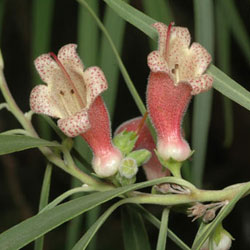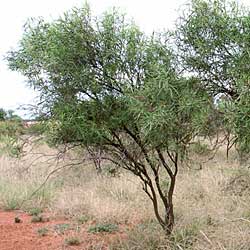Eremophila longifolia
Berrigan Emubush, Dogwood, Long-leaved Eremophila
Eremophila longifolia (R.Br.) F.Muell.
 Eremophila longifolia belongs to the family Myoporaceae. It is distributed in arid and semi-arid regions of all mainland states, and is absent from the wetter coastal belt along eastern Australia and south-western Western Australia.
Eremophila longifolia belongs to the family Myoporaceae. It is distributed in arid and semi-arid regions of all mainland states, and is absent from the wetter coastal belt along eastern Australia and south-western Western Australia.
E. longifolia is an evergreen rounded shrub to small tree growing 4-8 m high. It has drooping branches with grey-green pendulous leaves, up to 20 cm long, narrow and tapered at both ends. Pink to brownish red tubular flowers, 2-3 cm long, grow in clusters of 1 to 5 in leaf axils, and may appear along branches. Some flowers are present all year, with profuse flowering from spring to early summer. Flowers only turn to fruit if there is enough rain. Fruit is globular with a diameter around 1 cm, fleshy and black-purple when ripe. Seed is a single hard four-celled stone.
In the wild E. longifolia provides food for many birds including emus, honeyeaters and the Australian bustard. It is also good fodder for cattle and sheep.
Indigenous people considered E. longifolia to be the most sacred and mystical plant species found in central Australia. It has many ceremonial and medicinal uses.
E. longifolia is not well known to cultivation. However, it is horticulturally valuable due to its attractive weeping habit, prolific showy flowers and general hardiness especially to drought. It would be ideal as a street tree, in landscaping, or dense stands make attractive screens or windbreaks.
E. longifolia is a very hardy plant that requires minimal care. It prefers an open sunny position with no shade, and will tolerate moderate frost. It needs well draining soil, not heavy clay. It is suited to dry climates but has been successfully cultivated in warm, temperate areas. It is extremely drought tolerant and once established, no watering is required. Too much water makes them susceptible to disease, root rot and frost damage.
E. longifolia will respond to heavy pruning, with fresh new growth within weeks. Root suckers can be beneficial forming a thicket of shrubs, otherwise suckers need to be removed by hand or with secateurs. Grafting has the benefit of eliminating root suckers.
E. longifolia can be propagated from seed, cuttings, transplanting root suckers or grafting. Cuttings may not strike easily, and propagation from seed is unreliable. The best method for propagation is to dig up some of the suckers and treat them the same way as cuttings. Stem cuttings should be collected when the plant is healthy.
There are a number of treatment methods for seeds including splitting fruits to extract seed, exposing seed to smoke, and scarification of seed surface to allow penetration of moisture and oxygen.
To grow in an urban garden it is best grafted onto Myoporum species, which are disease resistant and better suited to heavier soils, more humid coastal climates, and higher rainfall. Myoporum insulare is very compatible for grafting eremophilas and makes an excellent rootstock.
In southern Australia E. longifolia should be planted at the end of March to establish sufficiently before winter. Some low phosphorus fertilizer mixed into soil when planting will boost initial growth.
Text: Alicia Brown (2010 Student Botanical Intern
Name Meaning: Eremophila longifoliaEremophila – from the Greek eremos meaning desert and philos meaning loving longifolia – from Latin, meaning long leaves. |
References
Association of Societies for Growing Australian Plants (ASGAP). 1997. Eremophilas for the garden. Society for Growing Australian Plants, South Australia.
Australian Native Plants Society. 2007. Eremophila longifolia. http://asgap.org.au/e-long.html
Centre for Plant Biodiversity Research. 2009. Australian Plant Name Index (APNI). IBIS database, Australian Government, Canberra. http://www.cpbr.gov.au/cgi-bin/apni
Centre for Plant Biodiversity Research. 2009. Australia’s Virtual Herbarium (AVH). IBIS database, Australian Government, Canberra.
http://www.anbg.gov.au/cgi-bin/avh.cgi/Barr, A., Chapman, J., Smith, N. & Beveridge, M. 1988. Traditional Bush Medicines: An Aboriginal Pharmacopoeia. Greenhouse Publications, Victoria.
Bindon, P. 1996. Useful Bush Plants. Western Australian Museum, Perth.
Boschen, N., Goods, M., & Wait, R. 2008. Australia’s Eremophilas: changing gardens for a changing climate. Blooming Books Pty Ltd, Melbourne.
Carmen, P. & Corsini, B. 2007. Top wedge grafting eremophilas. Combined Proceedings of the International Plant Propagators’ Society, 57:230-3.
Chinnock, R.J. 1992. PlantNET New South Wales Flora Online: Eremophila longifolia.
http://pngplants.org/cgi-bin/NSWfl.pl?page=nswfl&lvl=sp&name=Eremophila~longifoliaChinnock, R.J. 2007. Eremophila and allied genera: a monograph of the Myoporaceae. Rosenberg Publishing Pty Ltd, South Australia.
Elliot, W.R. & Jones, D.L. 1984. Encyclopaedia of Australian plants suitable for cultivation, Vol. 3 Lothian Publishing Company Pty Ltd, Melbourne.
Taylor, D. (Pers. comm.). Horticulturalist, Australian National Botanic Gardens, Canberra. 10th Feb 2010.
Weber, H. 2010. Australian Plants Online: Eremophila longifolia. http://asgap.org.au/APOL15/sep99-2.html (Accessed 29/01/10)
Wrigley, J. & Fagg, M. 1996. Australian Native Plants: Propagation, Cultivation and Use in Landscaping (4th ed). Reed Books, Australia.
![An Australian Government Initiative [logo]](/images/austgovt_brown_90px.gif)



